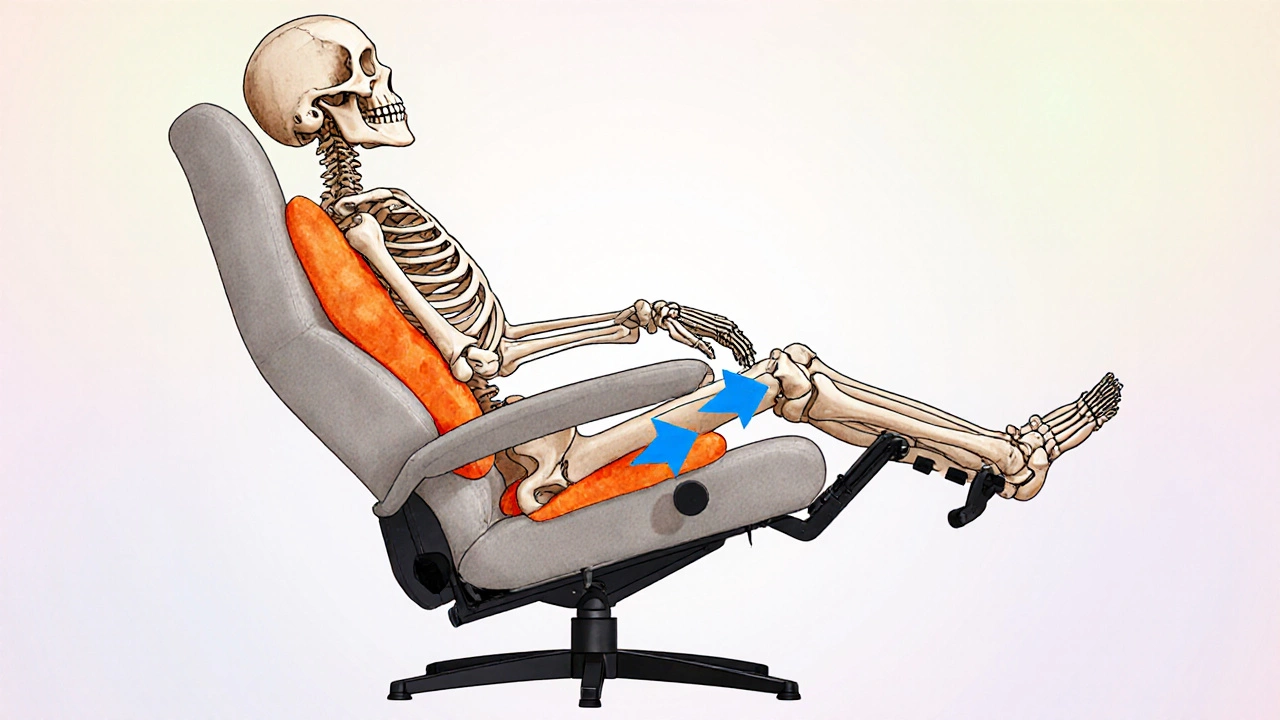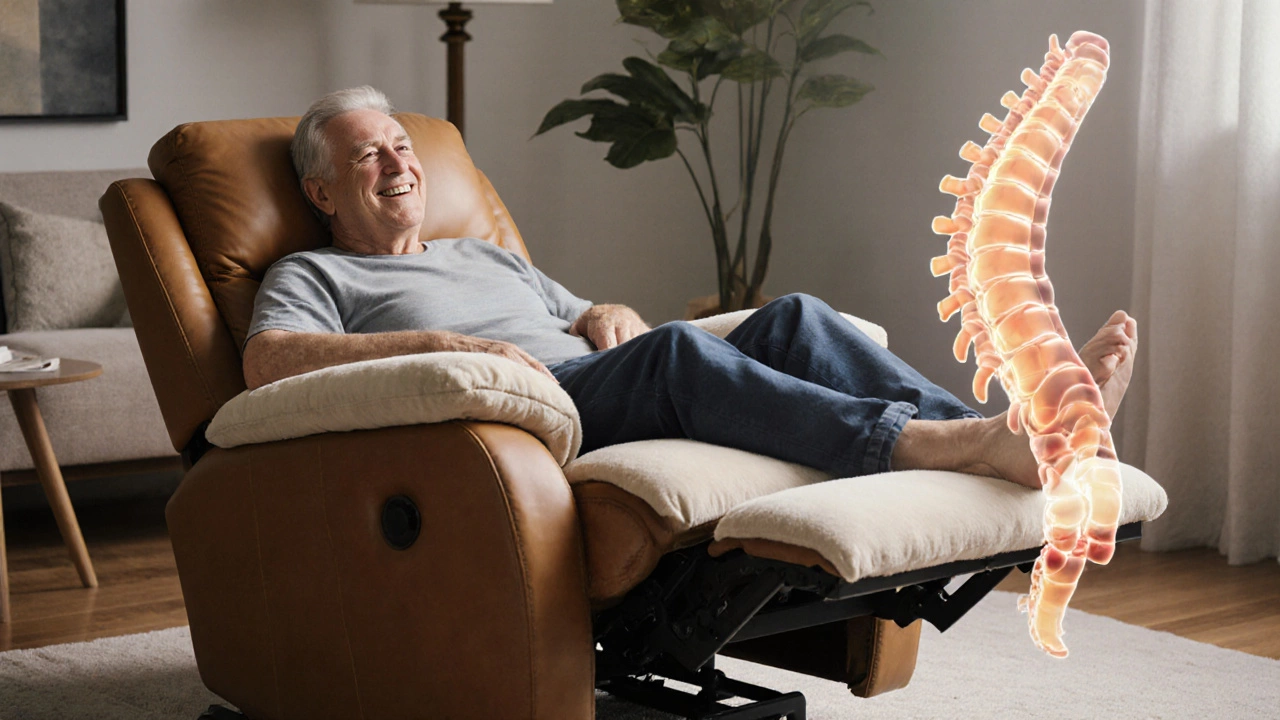Ergonomic Recliner Score Calculator
Recliner Parameters
Ideal range: 110°-120°
1 = No support, 5 = Excellent contoured support
Ideal range: 35-45 kg/m³
Your Ergonomic Score
Your recliner may contribute to back strain. Consider adjusting your position or consulting a professional.
Key Findings
Key Takeaways
- Modern Lazyboy recliners can be back‑friendly if you pick the right model and sit correctly.
- Critical features are lumbar support, adjustable tilt angle, and cushion density.
- Over‑reliance on any recliner - even a premium one - can cause or worsen back pain when used for long periods.
- Simple habits like keeping feet flat, aligning the spine, and limiting recline time dramatically reduce risk.
- If you already have chronic back issues, consider a medical‑grade recliner or an alternative seating option.
When you sink into a Lazyboy recliner is a high‑end recliner brand known for its powered mechanisms, plush cushioning, and signature "zero‑gravity" positions, it feels like the ultimate way to unwind. But the moment you hear "back pain" in the same breath, doubt creeps in. Is that plush comfort a myth for spinal health, or does it hide a hidden danger?
In this article we’ll break down the science of sitting, map out the design elements that matter, and give you a practical checklist so you can enjoy a Lazyboy (or any recliner) without waking up with a sore back.
How Your Spine Reacts to a Recliner
The human spine is a flexible column of vertebrae, discs, and ligaments that thrives on neutral alignment. When you sit in a traditional chair, the hips should sit level with the knees, and the lumbar curve should retain its natural inward bend. A recliner changes that geometry in three ways:
- Hip Angle: The seat tilts backward, raising the hips relative to the knees. This can reduce pressure on the intervertebral discs - good for short rests - but if the angle exceeds 130°, the lumbar curve flattens, putting stress on the lower back.
- Lumbar Support: Many recliners embed a padded lumbar pad. Properly positioned, it fills the natural curve; misplaced, it pushes the spine forward and creates a kyphotic posture.
- Footrest Elevation: When the footrest lifts, the knees flex further, which can improve circulation but also pull the pelvis into posterior tilt, again flattening the lumbar spine.
These biomechanical shifts are not inherently bad - they’re simply different. The key is whether the recliner’s adjustments let you maintain a neutral spinal alignment or force you into a slouched position.
Features That Make a Recliner Back‑Friendly
Not every Lazyboy model is created equal. Below are the attributes that separate a back‑friendly recliner from a pain‑producer.
| Attribute | Back‑Friendly | Poor‑Support |
|---|---|---|
| Lumbar Support | Adjustable, contoured pad that aligns with the natural L‑curve | Fixed or absent pad, often too high or low |
| Seat Tilt Angle | 0°-130° range, lockable at neutral or slight recline | Unlimited tilt, often >150° without lock |
| Cushion Density | Medium‑firm foam (approx. 35-45kg/m³) with memory‑foam overlay | Very soft, low‑density foam that compresses quickly |
| Footrest Mechanism | Independent lift, adjustable height, and optional swivel | Fixed height, forces knees into deep flexion |
| Adjustability | Multiple control points: lumbar, headrest, footrest, recline speed | One‑click recline, no fine‑tuning |
When you shop, look for models that advertise “custom lumbar support,” “memory foam cushions,” and “zero‑gravity lock.” Those terms usually signal the design features above.

Common Back Problems Linked to Recliner Use
Even a well‑designed recliner can become a culprit if misused. Here are the most frequent complaints and why they happen.
- Lower‑Back Strain: Happens when the lumbar pad is too soft or positioned too high, flattening the lumbar curve.
- Neck Pain: Occurs if the headrest is too low and the user leans forward to see the TV.
- Sciatica Flare‑Ups: Deep knee flexion on a high footrest can compress the piriformis muscle, aggravating the sciatic nerve.
- Postural Fatigue: Sitting for more than 30‑45minutes in a recline position can weaken core muscles, making it harder to sit upright later.
Most of these issues resolve by adjusting the recliner’s controls or limiting continuous use.
How to Sit Correctly in a Lazyboy Recliner
Follow this step‑by‑step routine each time you settle in. It takes under a minute but pays off in hours of comfort.
- Start with the seat in an upright position (0°-10° tilt). Ensure your feet are flat on the floor.
- Activate the lumbar pad and set it so the top of the pad rests just below your belly button. You should feel a gentle cradle.
- Adjust the headrest so the top aligns with the crown of your head. Your chin should be parallel to the floor.
- Press the recline button until the seat reaches 110°‑120°. This angle preserves lumbar curvature while allowing a relaxed posture.
- Raise the footrest so your knees form a 90° angle. If you need extra height, place a small cushion under the footrest.
- Take a deep breath, engage your core lightly, and sit back. You should feel even pressure across the thighs and the lower back.
Remember to stand up or shift position every 30‑45minutes. Even a premium recliner isn’t a substitute for movement.
When a Recliner Might Not Be the Best Choice
If you have any of the following conditions, reconsider prolonged recliner use or consult a physiotherapist.
- Diagnosed degenerative disc disease.
- Severe chronic low‑back pain that worsens with forward flexion.
- Post‑surgical spinal fusion that limits range of motion.
- Advanced osteoporosis (risk of compression fractures).
In these cases, a medical‑grade ergonomic chair with active lumbar support and a higher seat height can be safer. Some users also switch to a recliner only for short naps and use a supportive office chair for daily tasks.
Choosing the Right Lazyboy Model for Your Back
Lazyboy offers several series. Here’s a quick cheat‑sheet.
- Premium Comfort Series: Features patented "Zero‑Gravity" tilt, custom lumbar, and memory‑foam cushions - best for back‑sensitive users.
- Classic Recline Series: Fixed lumbar pad, basic tilt - suitable for occasional use but not ideal for daily long‑hour sitting.
- Power‑Lift Series: Motorized footrest and headrest, adjustable lumbar - great for seniors who need assistance with movement.
Read the spec sheet and look for the attributes in the comparison table above. If the model scores low on lumbar adjustability or cushion firmness, keep looking.
Quick Checklist Before Buying a Recliner
- Does the recliner have an independent lumbar adjustment?
- Can you lock the seat at 110°‑120°?
- Is the cushion density medium‑firm (35‑45kg/m³)?
- Is the footrest height‑adjustable?
- Is there a warranty covering the mechanism for at least 5years?
Say “yes” to at least four of these, and you’re on the right track.
Frequently Asked Questions
Do Lazyboy recliners cause permanent back damage?
No. A well‑designed recliner won’t damage the spine on its own. Problems arise from poor posture, excessive sitting time, or using a model without proper lumbar support. Adjust the recline angle and lumbar pad, and limit sessions to 30‑45minutes to stay safe.
What is the ideal recline angle for lower‑back health?
Most ergonomists recommend 110°‑120°. This keeps the lumbar curve intact while still providing a relaxed position. Angles beyond 140° start to flatten the curve and increase disc pressure.
Can I add extra lumbar support to an existing recliner?
Yes. After‑market lumbar cushions-especially those with adjustable straps-can be affixed to most recliners. Look for a firm, contoured pad that sits just above the hips.
Is a power‑lift recliner better for people with back pain?
Power‑lift models often provide finer adjustments for headrest, footrest, and lumbar support, which can help fine‑tune posture. However, the underlying cushion and tilt mechanics still matter, so choose a power‑lift unit that also meets the density and lumbar criteria above.
How often should I replace the cushions in my recliner?
High‑quality foam typically holds up 7‑10years with regular use. If you notice permanent indentations, sagging, or loss of support, it’s time for a replacement, especially if you suffer from back pain.
Bottom line: Lazyboy recliners aren’t a hidden health trap, but they aren’t a free pass either. By picking a model with proper lumbar support, setting the angle to preserve your natural curvature, and limiting continuous sitting, you can enjoy that plush feel without waking up with a sore back.

